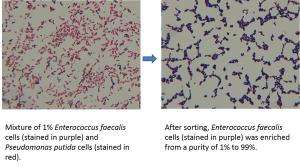High-throughput method for sorting cells

UH Mānoa College of Engineering mechanical engineer Yi Zuo has developed a new, high-throughput method for sorting cells capable of separating 10 billion bacterial cells in 30 minutes.
The finding has already proven useful for studying bacterial cells and microalgae, and could one day have direct applications for biomedical research and environmental science—basically any field in which a large quantity of microbial samples need to be processed.
The new method was described in a September 2014 publication in the scientific journal Analytical Chemistry, "Surface free energy activated high-throughput cell sorting."
Almost all of today's previously existing cell-sorting methods rely on what is called a single-cell analysis platform. These methods sort cells by running each individual cell through a kind of gateway that nabs out the ones that embody a single, defined physical property. Such methods can be designed to sort cells by size or to identify cells that display a targeted feature, such as a fluorescent dye that has been added.
Zuo's method is different. It is a bulk method that sorts different cell populations by tuning their solubility.
"It has no apparent limitations in sorting throughput," said Zuo, who came up with the original idea while teaching a UH Mānoa graduate level mechanical engineering class, ME650 Surface Phenomena. "We can separate 10 billion bacterial cells within 30 minutes."
The new method relies on a measurement principle that sorts cells by differentiating their characteristic surface free energies.
For liquid surfaces, surface free energy is equal to surface tension. But for solid surfaces, such as the surface of cells, surface free energy cannot be measured directly. Instead, surface free energy for solids was previously estimated using a contact angle measurement with complicated theoretical interpretations.
"Although plausible, this principle was very hard to implement," Zuo said. "Compared to other cell properties, such as size and deformability, it is technically challenging to determine their surface free energy. Only recently we developed a novel spectrophotometric method for directly determining the surface free energy of live cells. Based on this technological advance, we are able to implement the principle of surface free energy-activated cell sorting."
Zuo did this research in collaboration with UH Mānoa civil engineer Tao Yan. Their research was supported in part by Zuo's National Science Foundation CAREER Award in 2013. Under this grant, Zuo is studying the molecular mechanisms of lung surfactant, which is crucial to maintaining normal respiratory function in air sacs of the lung. Zuo hopes to help expand the use of clinical surfactants to treat various neonatal and adult respiratory diseases, including respiratory distress syndrome.
The University of Hawai'i Office of Technology Transfer and Economic Development (OTTED) has filed a provisional U.S. patent application for the new cell-sorting method, "Surface Free Energy Based Particle Sorting."
More information: Zhang X, Zhang Q, Yan T, Jiang Z, Zhang X, Zuo YY, "Surface free energy activated high-throughput cell sorting," Anal. Chem. (2014) DOI: 10.1021/ac503100a.
Journal information: Analytical Chemistry
Provided by University of Hawaii at Manoa



















